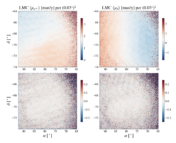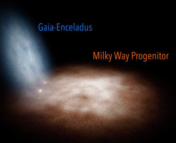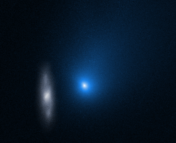Kathryn Neugent is a third year PhD candidate at the University of Washington and a research associate at Lowell Observatory. Her research focuses on observational studies of massive stars in the galaxies of the Local Group and for her thesis she’s constraining the binary fraction of Red Supergiants. Outside of astronomy, she enjoys hiking, knitting, and napping.
Title: Evolved Massive Stars at Low-metallicity I. A Source Catalog for the Small Magellanic Cloud
Authors: Ming Yang, Alceste Z. Bonanos, Bi-Wei Jiang, Jian Gao, Panagiotis Gavras, Grigoris Maravelias, Yi Ren, Shu Wang, Meng-Yao Xue, Frank Tramper, Zoi T. Spetsieri, and Ektoras Pouliasis
First Author’s Institute: IAASARS, National Observatory of Athens, Vas. Pavlou and I. Metaxa, Penteli 15236, Greece
Status: Accepted in A&A
What is a red supergiant and why are they awesome?
Red Supergiants (RSGs) are evolved massive stars that begin their lives on the main sequence as 8-30M☉ OB stars. After burning through their hydrogen, they evolve off of the main sequence, through the short lived (thousands of years) yellow supergiant phase, before cooling down to a couple thousands of degrees Kelvin and expanding to hundreds of solar radii. Here they remain until they exhaust their energy supply and end their lives as spectacular supernovae. RSGs that are bright in the night sky include Betelgeuse and Antares.
Understanding how many RSGs exist gives us more than just a number. Massive stars such as RSGs are the cosmic engines that provide important energy input and chemical enrichment on galactic scales. Their UV radiation ionizes HII regions and powers the far-infrared luminosities of distant galaxies. They are the primary sources of carbon and oxygen and their explosive deaths as supernovae produce many elements in the universe heavier than iron as they enrich the surrounding interstellar matter. Quantifying their numbers in galaxies other than our own gives us greater insight into how our universe will evolve in the future. But, given that they’re so large (in both mass and radii), they must be easy to find, right? Well, kinda …
How do we find RSGs?
The recent paper by Ming Yang and collaborators discusses finding these bloated evolved stars in our neighboring irregular galaxy, the Small Magellanic Cloud (SMC). While RSGs are very luminous (100,000 times the luminosity of the Sun or more), their visual magnitudes decrease quite substantially when you put them as far away as the SMC. In fact, they end up being about the same brightness as red halo giants in our own galaxy. So, how do you differentiate between the two? Up until recently, the primary way was by measuring their radial velocities, or how fast the stars are moving. This is done by taking spectra of each star and measuring the doppler shift in their spectral lines. Since the SMC has a systemic radial velocity of around 160 km/s, stars with radial velocities near this value are most likely SMC members while stars with radial velocities near 0 km/s are most likely foreground stars, between us and the SMC. A radial velocity histogram of candidate SMC RSGs is shown below.
However, obtaining spectra of individual RSG candidates is observationally expensive and thus systematic full-galaxy RSG searches have been lacking. But then came the age of Gaia, a space observatory in the process of mapping the positions, distances, and motions of around a billion stars. Gaia now gives us the parallax, and thus a distance estimate, to stars both within our own galaxy and those of the Local Group, such as the SMC. Using this, it is possible to remove the foreground stars using cuts in parallax and identify the RSGs without spectroscopy! Awesome, so are we done? Not quite …
Removing the Contaminants
The lower luminosity RSGs are additionally contaminated by the brightest Asymptotic Giant Branch (AGB) stars which are evolved low mass stars. However, in this new paper, Yang et al. (2019) find that with the right set of magnitude-color cuts, it is possible to separate out the RSGs from the AGBs, as is shown in Figure 2 below.
Using Gaia to remove foreground stars and color-color cuts to remove AGB stars, Yang et al. (2019) identified 1,405 RSGs and argue that 99.5% of those targets are genuine SMC members. They additionally cross-matched their results against catalogs with photometry in 50 different bands including 21 optical and 29 infrared as well as radial velocity measurements. While they point out that this isn’t a complete list of RSGs in SMC due to crowding complications, this work serves as a first attempt at fully characterizing the RSG population of the SMC.
Featured Image Credit: ESO/M. Kornmesser




